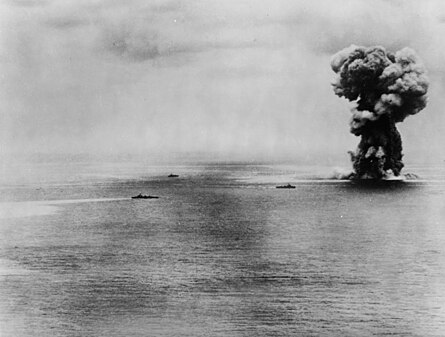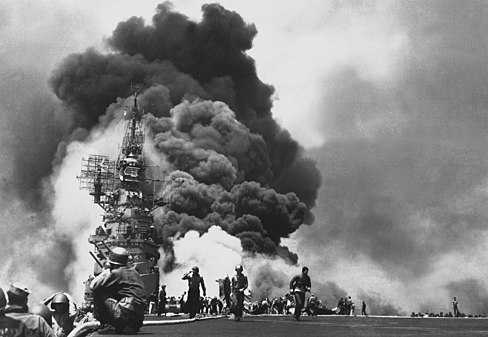
A | B | C | D | E | F | G | H | CH | I | J | K | L | M | N | O | P | Q | R | S | T | U | V | W | X | Y | Z | 0 | 1 | 2 | 3 | 4 | 5 | 6 | 7 | 8 | 9
| Battle of Okinawa | |||||||
|---|---|---|---|---|---|---|---|
| Part of the Volcano and Ryukyu Islands campaign of the Pacific Theater (World War II) | |||||||
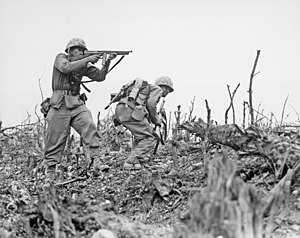 1st Marine Regiment during fighting at Wana Ridge during the Battle of Okinawa, May 1945 | |||||||
| |||||||
| Belligerents | |||||||
|
Ground forces: Naval forces: |
| ||||||
| Commanders and leaders | |||||||
|
|
| ||||||
| Units involved | |||||||
|
Ground units: Naval units:
|
Ground units:
Naval units: | ||||||
| Strength | |||||||
|
~541,000 in Tenth Army ~183,000 combat troops[3] rising to ~250,000[4]: 567 |
~76,000+ Japanese soldiers ~40,000+ Okinawan conscripts[5] | ||||||
| Casualties and losses | |||||||
|
Battle casualties: ~50,000, including ~12,500 dead[6][7] Army: 19,929[a] Navy: 10,007 at Okinawa,[b] 1,294 on USS Franklin[c] Marines: 19,460[d] Non-battle casualties: 26,211 to 33,096 (all causes)[14] Total casualties: ~76,000 to 84,000 Materiel: 375 tanks destroyed[15] 13 destroyers sunk 15 amphibious ships sunk 8 other ships sunk 386 ships damaged 763 aircraft lost[4]: 573 [16]: 473 |
Battle & Non-battle casualties: 94,136 soldiers and sailors dead (all causes)[e] 4,037 dead from Yamato task force[18] 7,401 captured (by 30 June)[19][f] Total casualties: ~105,000 to 110,000 Materiel: 1 battleship sunk 1 light cruiser sunk 5 destroyers sunk 9 other warships sunk 1,430 aircraft lost[20] 27 tanks destroyed 743–1,712 artillery pieces, anti-tank guns, mortars and anti-aircraft guns[16]: 91–92 | ||||||
| 40,000–150,000 civilians dead[21][22][g] | |||||||
Location within Japan | |||||||
The Battle of Okinawa (Japanese: 沖縄戦, Hepburn: Okinawa-sen), codenamed Operation Iceberg,[24]: 17 was a major battle of the Pacific War fought on the island of Okinawa by United States Army and United States Marine Corps forces against the Imperial Japanese Army.[25][26] The initial invasion of Okinawa on 1 April 1945 was the largest amphibious assault in the Pacific Theater of World War II.[27][28] The Kerama Islands surrounding Okinawa were preemptively captured on 26 March by the 77th Infantry Division. The 82-day battle lasted from 1 April until 22 June 1945. After a long campaign of island hopping, the Allies were planning to use Kadena Air Base on the large island of Okinawa as a base for Operation Downfall, the planned invasion of the Japanese home islands, 340 mi (550 km) away.
The United States created the Tenth Army, a cross-branch force consisting of the U.S. Army 7th, 27th, 77th and 96th Infantry Divisions with the 1st, 2nd, and 6th Marine Divisions, to fight on the island. The Tenth Army was unique in that it had its own Tactical Air Force (joint Army-Marine command) and was supported by combined naval and amphibious forces. Opposing the Allied forces on the ground was the Japanese Thirty-Second Army. The Battle of Okinawa was the single longest sustained carrier campaign of the Second World War.[29]
The battle has been referred to as the "typhoon of steel" in English, known in Japanese as "tetsu no bōfū".[30][31] The nicknames refer to the ferocity of the fighting, the intensity of Japanese kamikaze attacks and the sheer numbers of Allied ships and armored vehicles that assaulted the island. The battle was the bloodiest and fiercest of the Pacific War, with some 50,000 Allied and around 100,000 Japanese casualties,[32][16]: 473–474 also including local Okinawans conscripted into the Japanese Army.[21] According to local authorities, at least 149,425 Okinawan people were killed, died by coerced suicide or went missing.[33]
In the naval operations surrounding the battle, both sides lost considerable numbers of ships and aircraft, including the Japanese battleship Yamato. After the battle, Okinawa provided a fleet anchorage, troop staging areas, and airfields in proximity to Japan for US forces in preparation for a planned invasion of the Japanese home islands.
Order of battle
Allied
In all, the US Army had over 103,000 soldiers (of these, 38,000+ were non-divisional artillery, combat support and HQ troops, with another 9,000 service troops),[34]: 39 over 88,000 Marines and 18,000 Navy personnel (mostly Seabees and medical personnel).[34]: 40 At the start of the Battle of Okinawa, the US Tenth Army had 182,821 personnel under its command.[34]: 40 It was planned that Lieutenant General Simon Bolivar Buckner Jr. would report to Vice Admiral Richmond K. Turner until the amphibious phase was completed, after which he would report directly to Admiral Raymond A. Spruance. Total aircraft in the US Navy, Marine and Army Air Force exceeded 3,000 over the course of the battle, including fighters, attack aircraft, scout planes, bombers and dive-bombers. The invasion was supported by a fleet consisting of 18 battleships, 27 cruisers, 177 destroyers/destroyer escorts, 39 aircraft carriers (11 fleet carriers, 6 light carriers and 22 escort carriers) and various support and troop transport ships.[35]
The British naval contingent accompanied 251 British naval aircraft and included a British Commonwealth fleet with Australian, New Zealand and Canadian ships and personnel.[36]
Japanese
The Japanese land campaign (mainly defensive) was conducted by the 67,000-strong (77,000 according to some sources) regular 32nd Army and some 9,000 Imperial Japanese Navy troops at Oroku Naval Base (only a few hundred of whom had been trained and equipped for ground combat), supported by 39,000 drafted local Ryukyuan people (including 24,000 hastily drafted rear militia called Boeitai and 15,000 non-uniformed laborers). The Japanese had used kamikaze tactics since the Battle of Leyte Gulf, but for the first time they became a major part of the defense. Between the American landing on 1 April and 25 May, seven major kamikaze attacks were attempted, involving more than 1,500 planes.
The 32nd Army initially consisted of the 9th, 24th and 62nd Divisions and the 44th Independent Mixed Brigade. The 9th Division was moved to Taiwan before the invasion, resulting in shuffling of Japanese defensive plans. Primary resistance was to be led in the south by Lieutenant General Mitsuru Ushijima, his chief of staff, Lieutenant General Isamu Chō and his chief of operations, Colonel Hiromichi Yahara. Yahara advocated a defensive strategy, whilst Chō advocated an offensive one.
In the north, Colonel Takehido Udo was in command. The naval troops were led by Rear Admiral Minoru Ōta. They expected the Americans to land 6–10 divisions against the Japanese garrison of two and a half divisions. The staff calculated that superior quality and numbers of weapons gave each US division five or six times the firepower of a Japanese division. To this, would be added the Americans' abundant naval and air firepower.
Japanese use of children

On Okinawa, the Imperial Japanese Army mobilized 1,780 schoolboys aged 14–17 years into front line service as an Iron and Blood Imperial Corps (Japanese: 鉄血勤皇隊, romanized: Tekketsu Kinnōtai), while female Himeyuri students were organized into a nursing unit.[32] This mobilization was conducted by an ordinance of the Ministry of the Army, not by law. The ordinances mobilized the students as volunteer soldiers for form's sake; in reality, the military authorities ordered schools to force almost all students to "volunteer" as soldiers; sometimes they counterfeited the necessary documents. About half of the Tekketsu Kinnōtai were killed, including in suicide bomb attacks against tanks and in guerrilla operations.
Among the 21 male and female secondary schools that made up these student corps, 2,000 students died on the battlefield. Even with the female students acting mainly as nurses to Japanese soldiers, they were still exposed to the harsh conditions of war.[37]
There was a hypnotic fascination to the sight so alien to our Western philosophy. We watched each plunging kamikaze with the detached horror of one witnessing a terrible spectacle rather than as the intended victim. We forgot self for the moment as we groped hopelessly for the thought of that other man up there.
The US Navy's Task Force 58, deployed to the east of Okinawa with a picket group of 6 to 8 destroyers, kept 13 carriers (7 fleet carriers and 6 light carriers) on duty from 23 March to 27 April and a smaller number thereafter. Until 27 April, a minimum of 14 and up to 18 escort carriers were in the area at all times. Until 20 April, British Task Force 57, with 4 large and 6 escort carriers, remained off the Sakishima Islands to protect the southern flank.[16]: 97
The protracted length of the campaign under stressful conditions forced Admiral Chester W. Nimitz to take the unprecedented step of relieving the principal naval commanders to rest and recuperate. Following the practice of changing the fleet designation with the change of commanders, US naval forces began the campaign as the US 5th Fleet under Admiral Spruance, but ended it as the 3rd Fleet under Admiral Halsey.
Japanese air opposition had been relatively light during the first few days after the landings. However, on 6 April the expected air reaction began with an attack by 400 planes from Kyushu. Periodic heavy air attacks continued through April. During the period of 26 March to 30 April, 20 American ships were sunk and 157 damaged by enemy action. By 30 April the Japanese had lost more than 1,100 planes to Allied naval forces alone.[16]: 102
Between 6 April and 22 June, the Japanese flew 1,465 kamikaze aircraft in large-scale attacks from Kyushu, 185 individual kamikaze sorties from Kyushu, and 250 individual kamikaze sorties from Taiwan, then called Formosa. While US intelligence estimated there were 89 planes on Formosa, the Japanese actually had about 700, dismantled or well camouflaged and dispersed into scattered villages and towns; the US Fifth Air Force disputed Navy claims of kamikaze coming from Formosa.[39][clarification needed]
The ships lost were smaller vessels, particularly the destroyers of the radar pickets, as well as destroyer escorts and landing ships. While no major Allied warships were lost, several fleet carriers were severely damaged. Land-based Shin'yō-class suicide motorboats were also used in the Japanese suicide attacks, although Ushijima had disbanded the majority of the suicide boat battalions before the battle because of expected low effectiveness against a superior enemy. The boat crews were re-formed into three additional infantry battalions.[40]
-
The super battleship Yamato explodes after persistent attacks from US aircraft.
-
American aircraft carrier USS Bunker Hill burns after being hit by two kamikaze planes within 30 seconds.
Operation Ten-Go
Operation Ten-Go (Ten-gō sakusen) was the attempted attack by a strike force of 10 Japanese surface vessels, led by Yamato and commanded by Admiral Seiichi Itō. This small task force had been ordered to fight through enemy naval forces, then beach Yamato and fight from shore, using her guns as coastal artillery and her crew as naval infantry. The Ten-Go force was spotted by submarines shortly after it left the Japanese home waters and was intercepted by US carrier aircraft.
Under attack from more than 300 aircraft over a two-hour span, the world's largest battleship sank on 7 April 1945 after a one-sided battle, long before she could reach Okinawa. (US torpedo bombers were instructed to aim for only one side to prevent effective counter flooding by the battleship's crew, and to aim for the bow or the stern where armor was believed to be the thinnest.) Of Yamato's screening force, the light cruiser Yahagi and 4 of the 8 destroyers were also sunk. The Imperial Japanese Navy lost some 3,700 sailors, including Admiral Itō, at the cost of 10 US aircraft and 12 airmen.
British Pacific Fleet
The British Pacific Fleet, taking part as Task Force 57, was assigned the task of neutralizing the Japanese airfields in the Sakishima Islands, which it did successfully from March 26 to April 10. On April 10, its attention was shifted to airfields in northern Formosa. The force withdrew to San Pedro Bay on April 23. On May 1, the British Pacific Fleet returned to action, subduing the airfields as before, this time with naval bombardment as well as aircraft. Several kamikaze attacks caused significant damage, but as the Royal Navy carriers had armored flight decks, they experienced only a brief interruption to their force's operations.[41][42]
-
Royal Navy Fleet Air Arm Avengers, Seafires and Fireflies on HMS Implacable warm up their engines before taking off.
-
HMS Formidable on fire after a kamikaze attack on May 4. The ship was out of action for fifty minutes.
Land battle
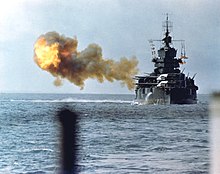
The land battle took place over about 81 days beginning on 1 April 1945. The first Americans ashore were soldiers of the 77th Infantry Division who landed in the Kerama Islands, 15 mi (24 km) west of Okinawa on 26 March. Subsidiary landings followed, and the Kerama group was secured over the next five days. In these preliminary operations, the 77th Infantry Division suffered 27 dead and 81 wounded, while the Japanese dead and captured numbered over 650. The operation provided a protected anchorage for the fleet and eliminated the threat from suicide boats.[16]: 50–60
On 31 March, Marines of the Amphibious Reconnaissance Battalion landed without opposition on Keise Shima, four islets just 8 mi (13 km) west of the Okinawan capital of Naha. A group of 155 mm (6.1 in) "Long Tom" artillery pieces went ashore on the islets to cover operations on Okinawa.[16]: 57
Northern Okinawa

The main landing was made by the XXIV Corps and the III Amphibious Corps on the Hagushi beaches on the western coast of Okinawa on 1 April. The 2nd Marine Division conducted a demonstration off the Minatoga beaches on the southeastern coast to deceive the Japanese about American intentions and delay movement of reserves from there.[16]: 68–74
Tenth Army swept across the south-central part of the island with relative ease, capturing the Kadena and the Yomitan airbases within hours of the landing.[24]: 67–69 [16]: 74–75 In light of the weak opposition, General Buckner decided to proceed immediately with Phase II of his plan, the seizure of northern Okinawa. The 6th Marine Division headed up the Ishikawa Isthmus and by 7 April had sealed off the Motobu Peninsula.[16]: 138–141
Six days later on 13 April, the 2nd Battalion, 22nd Marine Regiment, reached Hedo Point at the northernmost tip of the island. By this point, the bulk of the Japanese forces in the north (codenamed Udo Force) were cornered on the Motobu Peninsula. The terrain was mountainous and wooded, with the Japanese defenses concentrated on Mount Yaedake, a twisted mass of rocky ridges and ravines on the center of the peninsula. There was heavy fighting before the Marines finally cleared Yaedake on 18 April.[16]: 141–148 However, this was not the end of ground combat in northern Okinawa. On 24 May, the Japanese mounted Operation Gi-gou: a company of Giretsu Kuteitai commandos were airlifted in a suicide attack on Yomitan. They destroyed 70,000 US gallons (260,000 L) of fuel and nine planes before being killed by the defenders, who lost two men.
Meanwhile, the 77th Infantry Division assaulted Ie Shima, a small island off the western end of the peninsula, on 16 April. In addition to conventional hazards, the 77th Infantry Division encountered kamikaze attacks and even local women armed with spears. There was heavy fighting before the area was declared secured on 21 April and became another airbase for operations against Japan.[16]: 149–183
Southern Okinawa




While the 6th Marine Division cleared northern Okinawa, the US Army 96th and 7th Infantry Divisions wheeled south across the narrow isthmus of Okinawa. The 96th Infantry Division began to encounter fierce resistance in west-central Okinawa from Japanese troops holding fortified positions east of Highway No. 1 and about 5 mi (8 km) northwest of Shuri, from what came to be known as Cactus Ridge.[16]: 104–105 The 7th Infantry Division encountered similarly fierce Japanese opposition from a rocky pinnacle located about 1,000 yd (910 m) southwest of Arakachi (later dubbed "The Pinnacle"). By the night of 8 April, American troops had cleared these and several other strongly fortified positions. They suffered over 1,500 battle casualties in the process while killing or capturing about 4,500 Japanese. Yet the battle had only begun, for it was realized that "these were merely outposts," guarding the Shuri Line.[16]: 105–108
The next American objective was Kakazu Ridge (26°15′32″N 127°44′13″E / 26.259°N 127.737°E), two hills with a connecting saddle that formed part of Shuri's outer defenses. The Japanese had prepared their positions well and fought tenaciously. The Japanese soldiers hid in fortified caves. American forces often lost personnel before clearing the Japanese out from each cave or other hiding place. The Japanese sent Okinawans at gunpoint out to obtain water and supplies for them, which led to civilian casualties. The American advance was inexorable but resulted in a high number of casualties on both sides.[16]: 110–125
As the American assault against Kakazu Ridge stalled, Lieutenant General Ushijima—influenced by General Chō—decided to take the offensive. On the evening of 12 April, the 32nd Army attacked American positions across the entire front. The Japanese attack was heavy, sustained, and well organized. After fierce close combat, the attackers retreated, only to repeat their offensive the following night. A final assault on 14 April was again repulsed. The effort led the 32nd Army's staff to conclude that the Americans were vulnerable to night infiltration tactics but that their superior firepower made any offensive Japanese troop concentrations extremely dangerous, and they reverted to their defensive strategy.[16]: 130–137
The 27th Infantry Division, which had landed on 9 April, took over on the right, along the west coast of Okinawa. General John R. Hodge now had three divisions in the line, with the 96th in the middle and the 7th to the east, with each division holding a front of only about 1.5 mi (2.4 km). Hodge launched a new offensive on 19 April with a barrage of 324 guns, the largest ever in the Pacific Ocean Theater. Battleships, cruisers, and destroyers joined the bombardment, which was followed by 650 Navy and Marine planes attacking the Japanese positions with napalm, rockets, bombs, and machine guns. The Japanese defenses were sited on reverse slopes, where the defenders waited out the artillery barrage and aerial attack in relative safety, emerging from the caves to rain mortar rounds and grenades upon the Americans advancing up the forward slope.[16]: 184–194
A tank assault to achieve breakthrough by outflanking Kakazu Ridge failed to link up with its infantry support attempting to cross the ridge and therefore failed with the loss of 22 tanks. Although flame tanks cleared many cave defenses, there was no breakthrough, and the XXIV Corps suffered 720 casualties. The losses might have been greater except for the fact that the Japanese had practically all of their infantry reserves tied up farther south, held there by another feint off the Minatoga beaches by the 2nd Marine Division that coincided with the attack.[16]: 196–207
At the end of April, after Army forces had pushed through the Machinato defensive line,[43] the 1st Marine Division relieved the 27th Infantry Division and the 77th Infantry Division relieved the 96th. When the 6th Marine Division arrived, the III Amphibious Corps took over the right flank and Tenth Army assumed control of the battle.[16]: 265

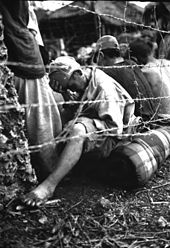
On 4 May, the 32nd Army launched another counter-offensive. This time, Ushijima attempted to make amphibious assaults on the coasts behind American lines. To support his offensive, the Japanese artillery moved into the open. By doing so, they were able to fire 13,000 rounds in support, but effective American counter-battery fire destroyed dozens of Japanese artillery pieces. The attack failed.[16]: 283–302
Buckner launched another American attack on 11 May. Ten days of fierce fighting followed. On 13 May, troops of the 96th Infantry Division and 763rd Tank Battalion captured Conical Hill (26°13′N 127°45′E / 26.21°N 127.75°E). Rising 476 ft (145 m) above the Yonabaru coastal plain, this feature was the eastern anchor of the main Japanese defenses and was defended by about 1,000 Japanese. Meanwhile, on the opposite coast, the 1st and 6th Marine Divisions fought for "Sugar Loaf Hill" (26°13′19″N 127°41′46″E / 26.222°N 127.696°E). The capture of these two key positions exposed the Japanese around Shuri on both sides. Buckner hoped to envelop Shuri and trap the main Japanese defending force.[16]: 311–359
By the end of May, monsoon rains which had turned contested hills and roads into a morass exacerbated both the tactical and medical situations. The ground advance began to resemble a World War I battlefield, as troops became mired in mud, and flooded roads greatly inhibited evacuation of wounded to the rear. Troops lived on a field sodden by rain, part garbage dump and part graveyard. Unburied Japanese and American bodies decayed, sank in the mud and became part of a noxious stew. Anyone sliding down the greasy slopes could easily find their pockets full of maggots at the end of the journey.[16]: 364–370
From 24 to 27 May the 6th Marine Division cautiously occupied the ruins of Naha, the largest city on the island, finding it largely deserted.[16]: 372–377
On 26 May aerial observers saw large troop movements just below Shuri. On 28 May Marine patrols found recently abandoned positions west of Shuri. By 30 May the consensus among Army and Marine intelligence was that the majority of Japanese forces had withdrawn from the Shuri Line.[16]: 391–392 On 29 May the 1st Battalion, 5th Marines (1/5 Marines) occupied high ground 700 yards (640 m) east of Shuri Castle and reported that the castle appeared undefended. At 10:15 Company A, 1/5 Marines occupied the castle.[16]: 395–496
Shuri Castle had been shelled by the battleship USS Mississippi for three days before this advance.[44] The 32nd Army withdrew to the south and thus the Marines had an easy task of securing Shuri Castle.[44][45] The castle, however, was outside the 1st Marine Division's assigned zone, and only frantic efforts by the commander and staff of the 77th Infantry Division prevented an American airstrike and artillery bombardment which would have resulted in many friendly fire casualties.[16]: 396
On 29 May a Confederate flag was raised over Shuri Castle,[46] before being removed and replaced by a US flag three days later on orders of General Buckner.[47]
The Japanese retreat, although harassed by artillery fire, was conducted with great skill at night and aided by the monsoon storms. The 32nd Army was able to move nearly 30,000 personnel into its last defense line on the Kiyan Peninsula, which ultimately led to the greatest slaughter on Okinawa in the latter stages of the battle, including the deaths of thousands of civilians. In addition, there were 9,000 IJN troops supported by 1,100 militia, with approximately 4,000 holed up at the underground headquarters on the hillside overlooking the Okinawa Naval Base in the Oroku Peninsula, east of the airfield.[16]: 392–394
On 4 June, elements of the 6th Marine Division launched an amphibious assault on the peninsula. The 4,000 Japanese sailors, including Admiral Ōta, all committed suicide within the hand-built tunnels of the underground naval headquarters on 13 June.[16]: 427–434 By 17 June, the remnants of Ushijima's shattered 32nd Army were pushed into a small pocket in the far south of the island to the southeast of Itoman.[16]: 455–4661
On 18 June, General Buckner was killed by Japanese artillery fire while monitoring the progress of his troops from a forward observation post. Buckner was replaced by Major General Roy Geiger. Upon assuming command, Geiger became the only US Marine to command a numbered army of the US Army in combat; he was relieved five days later by General Joseph Stilwell. On 19 June, Brigadier General Claudius Miller Easley, the commander of the 96th Infantry Division, was killed by Japanese machine-gun fire, also while checking on the progress of his troops at the front.[16]: 461
The last remnants of Japanese resistance ended on 21 June, although some Japanese continued hiding, including the future governor of Okinawa Prefecture, Masahide Ōta.[48] Ushijima and Chō committed suicide by seppuku in their command headquarters on Hill 89 in the closing hours of the battle.[16]: 468–471 Colonel Yahara had asked Ushijima for permission to commit suicide, but the general refused his request, saying: "If you die there will be no one left who knows the truth about the battle of Okinawa. Bear the temporary shame but endure it. This is an order from your army commander."[38]: 723 Yahara was the most senior officer to have survived the battle on the island, and he later authored a book titled The Battle for Okinawa. On 22 June Tenth Army held a flag-raising ceremony to mark the end of organized resistance on Okinawa. On 23 June a mopping-up operation commenced, which concluded on 30 June.[16]: 471–473
On 15 August 1945, Admiral Matome Ugaki was killed while part of a kamikaze raid on Iheyajima island. The official surrender ceremony was held on 7 September, near the Kadena Airfield.
Casualties

The Battle of Okinawa was the bloodiest battle of the Pacific War.[49][50] The most complete tally of deaths during the battle is at the Cornerstone of Peace monument at the Okinawa Prefectural Peace Memorial Museum, which identifies the names of each individual who died at Okinawa in World War II. As of 2023, the monument lists 242,046 names, including 149,634 Okinawans, 77,823 Imperial Japanese soldiers, 14,010 Americans,[33] and smaller numbers of people from South Korea (381), the United Kingdom (82), North Korea (82) and Taiwan (34).[33]
The numbers correspond to recorded deaths during the Battle of Okinawa from the time of the American landings in the Kerama Islands on 26 March 1945 to the signing of the Japanese surrender on 2 September 1945, in addition to all Okinawan casualties in the Pacific War in the 15 years from the Manchurian Incident, along with those who died in Okinawa from war-related events in the year before the battle and the year after the surrender.[51] 234,183 names were inscribed by the time of unveiling, and new names are added as necessary.[52][53][54] 40,000 of the Okinawan civilians killed had been drafted or impressed by the Japanese army and are often counted as combat deaths.
Military losses
American

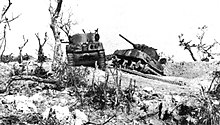
The Americans suffered some 48,000 casualties, not including some 33,000 non-battle casualties (psychiatric, injuries, illnesses), of whom over 12,000 were killed or missing. Killed in action were 4,907 Navy, 4,675 Army, and 2,938 Marine Corps personnel; when excluding naval losses at sea and losses on the surrounding islands (such as Ie Shima), 6,316 killed and over 30,000 wounded occurred on Okinawa proper. [14] Other authors such as John Keegan have come up with higher numbers.[55] The battle caused more than twice the number of American casualties than both the Guadalcanal Campaign and Battle of Iwo Jima combined, with the Japanese kamikaze effort causing the American Navy to suffer more casualties than any previous engagement in the Atlantic or Pacific.[56]
The most famous American casualty was Lieutenant General Buckner, whose decision to attack the Japanese defenses head-on, although extremely costly in American lives, was ultimately successful. Four days from the closing of the campaign, Buckner was killed by Japanese artillery fire, which blew lethal slivers of coral into his body, while inspecting his troops at the front line. He was the highest-ranking US officer to be killed by enemy fire during the Second World War. The day after Buckner was killed, Brigadier General Easley was killed by Japanese machine-gun fire. War correspondent Ernie Pyle was also killed by Japanese machine-gun fire on Ie Shima, a small island just off of northwestern Okinawa.[57]


Aircraft losses over the three-month period were 768 US planes, including those bombing the Kyushu airfields launching kamikazes. Combat losses were 458, and the other 310 were operational accidents. At sea, 368 Allied ships—including 120 amphibious craft—were damaged while another 36—including 15 amphibious ships and 12 destroyers—were sunk during the Okinawa campaign. The US Navy's dead exceeded its wounded, with 4,907 killed and 4,874 wounded, primarily from kamikaze attacks.[58]
American personnel casualties included thousands of cases of mental breakdown. According to the account of the battle presented in Marine Corps Gazette:
More mental health issues arose from the Battle of Okinawa than any other battle in the Pacific during World War II. The constant bombardment from artillery and mortars coupled with the high casualty rates led to a great deal of personnel coming down with combat fatigue. Additionally, the rains caused mud that prevented tanks from moving and tracks from pulling out the dead, forcing Marines (who pride themselves on burying their dead in a proper and honorable manner) to leave their comrades where they lay. This, coupled with thousands of bodies both friend and foe littering the entire island, created a scent you could nearly taste. Morale was dangerously low by May and the state of discipline on a moral basis had a new low barometer for acceptable behavior. The ruthless atrocities by the Japanese throughout the war had already brought on an altered behavior (deemed so by traditional standards) by many Americans resulting in the desecration of Japanese remains, but the Japanese tactic of using the Okinawan people as human shields brought about a new aspect of terror and torment to the psychological capacity of the Americans.[21]
Medal of Honor recipients from Okinawa are:
- Beauford T. Anderson – 13 April
- Richard E. Bush – 16 April
- Robert Eugene Bush – 2 May
- Henry A. Courtney Jr. – 14–15 May
- Clarence B. Craft – 31 May
- James L. Day – 14–17 May
- Desmond Doss – 29 April – 21 May
- John P. Fardy – 7 May
- William A. Foster – 2 May
- Harold Gonsalves – 15 April
- William D. Halyburton Jr. – 10 May
- Dale M. Hansen – 7 May
- Louis J. Hauge Jr. – 14 May
- Elbert L. Kinser – 4 May
- Fred F. Lester – 8 June
- Martin O. May – 19–21 April
- Richard M. McCool Jr. – 10–11 June
- Robert M. McTureous Jr. – 7 June
- John W. Meagher – 19 June
- Edward J. Moskala – 9 April
- Joseph E. Muller – 15–16 May
- Alejandro R. Ruiz – 28 April
- Albert E. Schwab – 7 May
- Seymour W. Terry – 11 May
The following table lists the Allied naval vessels that received damage or were sunk in the Battle of Okinawa between 19 March – 30 July 1945. The table lists a total of 147 damaged ships, five of which were damaged by enemy suicide boats and another five by mines. During the naval battle, which started before the amphibious landings on Okinawa on 1 April, USS Franklin suffered over 800 killed and missing and USS Bunker Hill suffered 396 killed and missing. These were the first and third largest loss of life on damaged or sunken American aircraft carriers during World War II. USS Franklin (hit by two bombs in a level bombing attack by a D4Y Suisei (Judy) on 19 March 1945) and USS Bunker Hill were the only two aircraft carriers that sustained very severe damage from Japanese attacks and as a result were the only aircraft carriers in the Essex class that did not experience any active service after the end of World War II. One source estimated that total Japanese sorties during the entire Okinawa campaign exceeded 3,700, with a large percentage being kamikaze attacks, and that the attackers damaged slightly more than 200 Allied vessels, with 4,900 naval officers and seamen killed and roughly 4,824 wounded or missing.[59] USS Thorton was damaged as the result of a collision with another US ship.
The Japanese air attacks were so intense that Fifth Fleet commander Admiral Spruance's flagships were struck two separate times (USS Indianapolis was hit in March and had to retire for repairs which forced him to transfer to USS New Mexico which was also hit in May). Fast Carrier Task Force commander Vice Admiral Marc Mitscher and his chief of staff Commodore Arleigh Burke were yards away from getting killed or wounded by kamikazes on his flagship USS Bunker Hill, which killed three of Mitscher's staff officers and eleven of his enlisted staff members and also destroyed his flag cabin along with all of his uniforms, personal papers, and possessions. Just three days later Mitscher's new flagship USS Enterprise was also struck by a kamikaze forcing him to have to change his flagship yet again. Both fleet carriers were knocked out for the rest of the war.[60]
* sunk or had to be scuttled due to irreparable damage. Of those sunk, the majority were relatively smaller ships; these included destroyers of around 300–450 feet. A few small cargo ships were also sunk, several containing munitions which caught fire.
# scrapped or decommissioned as a result of damage.
| Day | Ship | Type | Cause | Killed | Wounded |
|---|---|---|---|---|---|
| 19 Mar 45 | USS Wasp | Carrier | Air attack, bomb through flight, & hangar decks | 102 | 269 |
| 19 Mar 45 | USS Franklin | Carrier | Air attack | 807 | 487 |
| 20 Mar 45 | USS Enterprise[62][63] | Carrier | Air attack, two near misses from bombs, at the same time of near misses immediately hit by two 5-inch AA shells from U.S. ships | 9 | 28 |
| 20 Mar 45 | USS Hasley Powell | Destroyer | Air attack, kamikaze | 12 | 29 |
| 24 Mar 45 | USS Nevada | Battleship | Air attack, kamikaze hit and knocked out 14-inch guns in turret number 3 | 11 | 49 |
| 26 Mar 45 | * USS Haligan | Destroyer | Mine, 3 miles SE of Maye Shima, exploded two forward magazines, bow blown off[64] | 153 | 39 |
| 26 Mar 45 | USS Kimberly | Destroyer | Air attack, kamikaze | 4 | 57 |
| 27 Mar 45 | USS Murray | Destroyer | Air attack, bomb | 1 | 116 |
| 27 Mar 45 | USS O'Brian | Destroyer | Air attack, Val kamikaze with bomb | 50 | 76 |
| 28 Mar 45 | * USS Skylark | Small Minesweeper | Mine, struck mines twice off Hagushi beaches | 5 | 25 |
| 28 Mar 45 | USS LSM(R)-188 | Landing Ship | Air attack, kamikaze | 15 | 32 |
| 29 Mar 45 | USS Wyandot | Attack Cargo Ship | Mine, possibly bomb | 0 | 1 |
| 31 Mar 45 | USS Indianapolis [h] | Cruiser | Air attack, kamikaze with bomb through fuel tanks and propeller shafts | 9 | 20 |
| 1 Apr 45 | USS Adams | Destroyer Minelayer | Air attack, kamikaze with bombs to fantail | 0 | 0 |
| 1 Apr 45 | USS Alpine | Attack Transport | Air attack, bomb and kamikaze | 16 | 27 |



